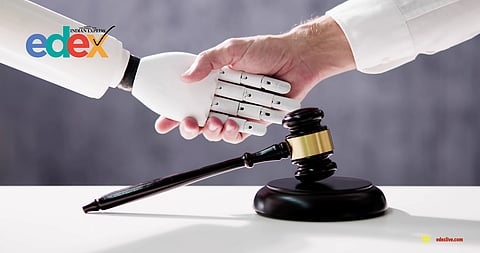

Few phrases encapsulate the despair of the Indian litigant more powerfully than Sunny Deol’s anguished outburst in Damini: “Tareekh pe tareekh” (hearing after hearing). It has become a cultural shorthand for the chronic paralysis of our judicial system, endless adjournments, interminable delays and an ever-mounting docket of cases. It is a significant erosion of the constitutional covenant that justice shall be ‘accessible, effective and timely’.
The consequences extend beyond individual hardship. A significant portion of these are civil disputes on the enforceability of contracts, sanctity of property rights, and predictability of commercial relations. Their prolonged pendency corrodes business confidence, undermines the ease of doing business, and exacts a measurable toll on India’s economic growth.
Judicial efficiency itself remains a serious concern. One promising pathway to address this lies in the adoption of artificial intelligence—not as a panacea, but as a force multiplier to streamline processes, reduce delays, and assist judges in decision-making without compromising judicial wisdom.
Civil disputes form the bulk of pendency and have the most direct bearing on economic growth. AI deployment here must prioritise throughput and standardisation. For example, in case triage. Machine learning classifiers can categorise cases by complexity and urgency. China’s ‘intelligent case division’ sorts routine matters into simplified workflows, while Estonia uses AI to automatically issue simple payment orders. In India, cheque dishonour matters—which constitute a significant share of criminal dockets, but are quasi-civil in nature—could be diverted to automated or semi-automated streams, freeing judges for complex disputes.
Second, automated document generation and verification. Language processing and character recognition systems can parse pleadings, identify defects, and auto-generate standardised drafts. The Hebei High Court in China processed 1.1 lakh cases and produced 7.8 lakh judicial documents in under a year with AI flagging defective filings at the threshold and ensuring compliance with codes.
The third is precedent recommendation and doctrinal consistency. Deep neural-network–based tools can extract fact patterns and push ‘similar case’ recommendations, as Shanghai’s ‘206 system’ does. In India, such systems could operationalise stare decisis by ensuring that high courts apply consistent standards in analogous disputes, directly addressing investor concerns about unpredictability in commercial litigation.
In criminal matters, AI must be tightly bound to preserve due process and dignity. Supervised machine-learning models have achieved high accuracy in predicting trial duration in Brazil’s labour courts. Applied in India, such models could identify undertrial cases at risk of prolonged pendency, enabling judicial prioritisation.
However, one must remember, an AI model is only as sound as the data that trains it, and when that data reflects existing social or institutional biases, the system’s recommendations will inevitably replicate and even amplify them. Studies from the US, for example, revealed that black defendants were disproportionately labelled as ‘high risk’ compared to white defendants with similar records. Scholars such as Solon Barocas and Andrew Selbst described this in 2016 as the ‘ratchet effect’, where historical inequalities are encoded into algorithmic decision-making. For this reason, AI in the judiciary must always be treated as advisory, subjected to rigorous bias audits, and deployed with full human oversight.
Third, speech recognition and evidence retrieval systems can transcribe proceedings, surface relevant exhibits, and push case-law prompts in real time. For Indian courts, this could mean fewer adjournments due to incomplete records and improved accuracy for appellate scrutiny.
Another area where AI could be useful is with the language of judgements which citizens can understand. The Supreme Court in 2022 had to set aside yet another Himachal Pradesh High Court judgement for being, in its words, “utterly incomprehensible”. One paragraph, for example, solemnly intoned: “However, the afore bar or embargo, against the institution, of the extant writ petition… is not a rigid or an absolute bar, rather it holds certain well expostulated exceptions”, before meandering through five sub-clauses with little punctuation to spare.
If even seasoned judges in the apex court cannot decipher such prose, what chance does the common citizen have? AI tools, trained to flag verbosity and promote plain-language drafting, could be invaluable here; not to write judgements, but to remind the judiciary that clarity, not convolution, is the first duty of justice.
Finally, the best place to deploy AI would be the lower judiciary because it is here that the sheer weight of pendency is felt most acutely and where citizens first experience the justice system. Unlike appellate courts that deal with complex questions, trial courts are inundated with routine, high-volume matters, execution petitions, minor criminal trials, and civil disputes. These require speed, consistency, and procedural integrity more than doctrinal innovation. If the higher judiciary sets constitutional standards, it is the lower judiciary where AI can most tangibly turn the promise of ‘speedy justice’ into reality.
[Wriiten by Aditya Sinha | Public policy professional]
(Views are personal)
(On X @adityasinha004)
